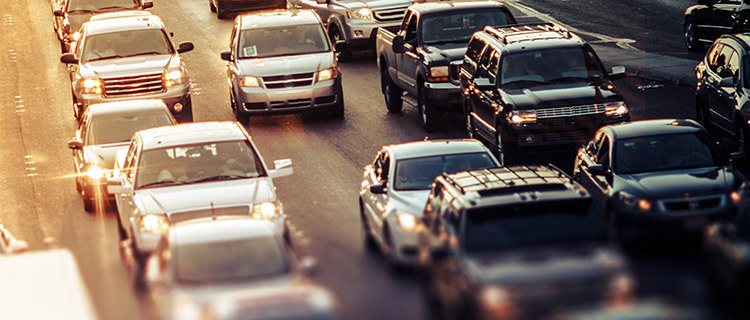
Part 1 of 2.
By Kate Martin/Carolina Public Press.
North Carolina, like many other states, has gambled on toll roads as a way to reduce congestion.
While a relatively recent addition to the state’s highways, some estimates say toll roads in the Triangle and Charlotte areas are drawing more drivers than officials initially predicted.
So, how are the toll roads doing at what they were supposed to accomplish — reducing congestion?
A Carolina Public Press investigation found that the state appears to lack clear answers and to be in no hurry to find out whether the wealth, materials, acreage, sweat and frustration sacrificed to create the new toll routes have been justified in each case or in any case.
Based on recent responses that Carolina Public Press received from the N.C. Department of Transportation, it appears the agency does not monitor the effects of these projects on congestion.
Jennifer Thompson, a spokeswoman with DOT, told CPP that the agency doesn’t track congestion “from a statewide level” or on toll roads.
Thompson said DOT also does not track vehicle counts on the relatively new Interstate 77 express lane, 26 miles of toll lane between Charlotte and Mooresville to the north.
She did not respond to additional questions from CPP.
Traffic counts along the toll route through northern Mecklenburg and southern Iredell counties are instead monitored by I-77 Mobility Partners, a limited liability company created to manage development, construction, maintenance and operation of the tollway.
Much of the 26 miles of toll lanes has been open for nearly six months. Through Nov. 16, according to a press release from I-77 Mobility Partners, drivers have taken more than 2.7 million trips on the express lanes by more than 515,000 different vehicles.
It was unclear what percentage of total traffic volume this represented. However, this rate of usage would mean that in any one minute on average between 11 and 12 cars were using some portion of the 26 miles of toll lanes, though usage was undoubtedly higher at peak times and less at others.
Usage may be increasing this month as well, with a final portion of the toll lane being completed.
While I-77 Mobility Partners has not directly addressed congestion, the private company’s statements suggest things could be improving along the route.
It calculates traffic speeds during rush hour as having improved between October 2018 and October 2019, with morning rush hour traffic driving 15% faster and the evening commute speeds up by 17 percent.
Of course, this is a comparison of traffic flow along the nearly finished route with flow when traffic was still snarled from construction, not with free-flowing traffic before anyone thought of adding a toll lane through the area.
The woes of congestion
Though a small delay may not seem like much to an individual driver, those chunks of time can add up.
In 2017, congestion in the United States cost drivers $166 billion, according to the 2019 Mobility Report by the Texas A&M Transportation Institute and traffic analytics company INRIX. The cost includes the value of a driver’s time in clogged lanes and the extra gas burned due to the delays.
According to INRIX’s report, drivers in the Charlotte area spent an extra 57 minutes in traffic due to congestion in 2017. This was when the route was under construction.
Meanwhile, Raleigh and Durham drivers spent extra time on the roads due to clogged lanes — 42 hours and 33 hours, respectively, the report said. Toll lanes in those areas had already been open for years.
Charlotte was named among the country’s 25 metro areas with the worst congestion in a separate INRIX report filed last year.
According to some experts, tolls can be just enough of a nudge for a driver to change the timing of his or her trip or avoid traveling altogether.
A small shift in the number of cars entering a highway can mean increased speeds for the other drivers, said Robert Krol, senior affiliated scholar at the Mercatus Center at George Mason University.
Krol, an economist by trade, said higher tolls as congestion increases have been effective in reducing congestion around the world.
He had no idea about actual numbers for North Carolina, though he expected the same principle would hold true here as well, even if the state doesn’t monitor the issue.
Of course, some tolls may be better designed and more effective for local traffic demands than others.
Not everyone agrees that tolls are a good idea. AAA, which advocates for motorists, recognizes that some tolls are inevitable but discourages their use and doubts that they are always necessary.
“AAA believes that while a toll-free system is preferred, tolls can be used with appropriate and necessary motorist protections in certain circumstances for new and existing corridors,” AAA spokeswoman Tiffany Wright told CPP. “We support the continued evaluation of alternative transportation funding solutions, including tolling. Sometimes rush hour traffic is simply unavoidable, but if you have the ability to schedule work and errands around heavy traffic, that’s obviously the best way to avoid congestion.”
Looking ahead
North Carolina is one of the fastest-growing states in the country. Since the 2010 census, the state has gained nearly 850,000 new residents, according to Carolina Demography.
The largest population growth has similarly centered on the Research Triangle and Charlotte, Carolina Demography says.
The state also projects by 2030, around 20% more people will live in the Charlotte and Raleigh areas.
Krol, the economist, said rapidly growing areas will need to increase traffic capacity, but tolling should be part of the solution.
“If you have a 20 percent population increase over the next 10 to 15 years, that’s a lot more cars on the road,” he said. “I would still argue, you want to increase tolling.”
—Martin is a reporter for Carolina Public Press
Next Month: New NC toll routes yet to prove they can be profitable





